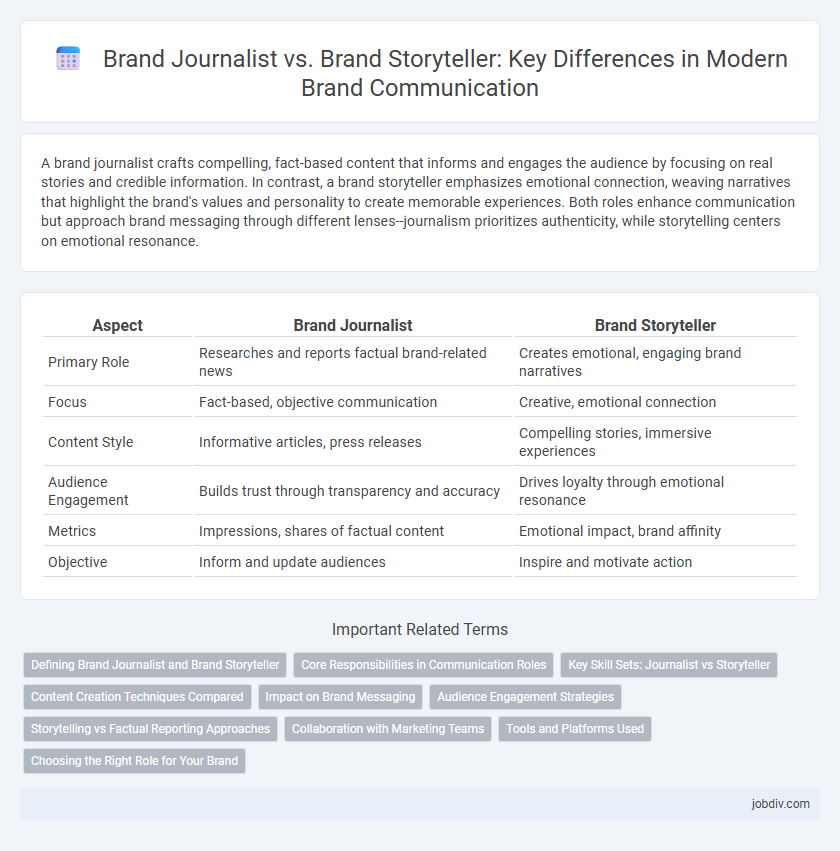A brand journalist crafts compelling, fact-based content that informs and engages the audience by focusing on real stories and credible information. In contrast, a brand storyteller emphasizes emotional connection, weaving narratives that highlight the brand's values and personality to create memorable experiences. Both roles enhance communication but approach brand messaging through different lenses--journalism prioritizes authenticity, while storytelling centers on emotional resonance.
Table of Comparison
| Aspect | Brand Journalist | Brand Storyteller |
|---|---|---|
| Primary Role | Researches and reports factual brand-related news | Creates emotional, engaging brand narratives |
| Focus | Fact-based, objective communication | Creative, emotional connection |
| Content Style | Informative articles, press releases | Compelling stories, immersive experiences |
| Audience Engagement | Builds trust through transparency and accuracy | Drives loyalty through emotional resonance |
| Metrics | Impressions, shares of factual content | Emotional impact, brand affinity |
| Objective | Inform and update audiences | Inspire and motivate action |
Defining Brand Journalist and Brand Storyteller
A Brand Journalist creates factual, news-style content focused on a brand's developments, industry insights, and customer impact to build credibility and transparency. A Brand Storyteller crafts compelling narratives that evoke emotions and connect audiences to the brand's values, mission, and unique personality. Both roles enhance brand communication but differ in approach: journalism emphasizes informative content, while storytelling prioritizes engaging, memorable experiences.
Core Responsibilities in Communication Roles
Brand Journalists focus on researching, writing, and delivering factual, news-based content that enhances brand credibility and informs the audience with accuracy. Brand Storytellers create emotional, narrative-driven content that connects with the audience on a personal level, shaping brand identity and fostering engagement. Both roles prioritize effective communication but differ in approach, with Brand Journalists emphasizing information dissemination and Brand Storytellers focusing on relationship-building through compelling narratives.
Key Skill Sets: Journalist vs Storyteller
Brand journalists excel in investigative research, fact-checking, and crafting accurate, objective narratives that align with journalistic standards. Brand storytellers focus on emotional engagement, creative storytelling techniques, and weaving compelling brand narratives that resonate with target audiences. The key skills for journalists include precision and credibility, while storytellers prioritize creativity and audience connection.
Content Creation Techniques Compared
Brand journalists prioritize factual reporting and objectivity, utilizing interview techniques and data-driven storytelling to create credible, informative content that builds trust. Brand storytellers focus on emotional engagement and narrative arcs, employing character-driven stories and immersive experiences to connect deeply with audiences. Both use multimedia elements, but brand journalists emphasize accuracy and newsworthiness, while brand storytellers aim for creativity and shareability.
Impact on Brand Messaging
Brand journalists deliver facts with precision, enhancing brand credibility through well-researched content that informs and educates audiences. Brand storytellers create emotional connections by crafting narratives that resonate personally, making the brand more memorable and relatable. Combining both approaches amplifies brand messaging effectiveness, balancing trustworthiness with emotional engagement.
Audience Engagement Strategies
Brand journalists prioritize factual reporting and data-driven narratives to build credibility and trust with their audience, often employing investigative techniques and customer insights to deliver timely, relevant content. Brand storytellers craft emotionally resonant stories using creative techniques such as character development and compelling visuals to foster deeper emotional connections and enhance brand loyalty. Both roles leverage tailored multimedia content and social listening tools to optimize audience engagement, but journalists emphasize authenticity and transparency while storytellers focus on memorable, immersive experiences.
Storytelling vs Factual Reporting Approaches
Brand journalists prioritize factual reporting by delivering accurate, research-based content that establishes credibility and trust with the audience. Brand storytellers emphasize emotional engagement through narrative techniques that create memorable experiences and strengthen brand identity. Combining journalistic integrity with compelling storytelling enhances both information dissemination and audience connection in communication strategies.
Collaboration with Marketing Teams
Brand journalists provide factual, news-driven content that aligns with marketing goals by delivering credible stories supported by data and research, enhancing brand authority. Brand storytellers craft emotionally engaging narratives that resonate with target audiences, helping marketing teams build deeper connections and brand loyalty. Collaboration between both roles ensures a balanced approach, combining authenticity and creativity to drive effective communication strategies.
Tools and Platforms Used
Brand journalists primarily utilize digital newsrooms, blog platforms, and press release distribution services to deliver fact-based, timely content that aligns with journalistic standards. Brand storytellers often leverage social media channels, video production tools, and interactive storytelling formats like podcasts or virtual reality to create emotionally engaging narratives that resonate with target audiences. Both roles employ analytics tools such as Google Analytics and social listening platforms to measure content performance and audience engagement across multiple digital touchpoints.
Choosing the Right Role for Your Brand
Brand journalists provide factual, news-driven content that builds credibility through research and objective reporting, ideal for brands seeking to establish authority and trust. Brand storytellers craft emotional, narrative-driven experiences that connect audiences on a personal level, perfect for brands aiming to foster engagement and loyalty. Selecting the right role depends on your brand's communication goals: prioritize brand journalism for informative transparency and brand storytelling for compelling emotional influence.
Brand Journalist vs Brand Storyteller Infographic

 jobdiv.com
jobdiv.com